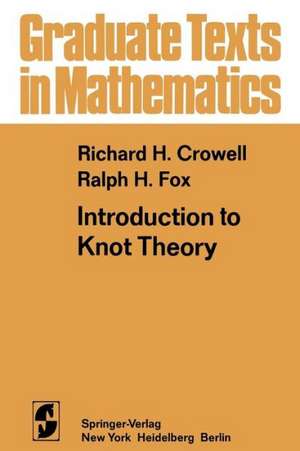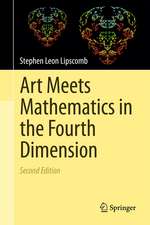Introduction to Knot Theory: Graduate Texts in Mathematics, cartea 57
Autor R. H. Crowell, R. H. Foxen Limba Engleză Paperback – 8 noi 2011
Din seria Graduate Texts in Mathematics
-
 Preț: 402.89 lei
Preț: 402.89 lei - 17%
 Preț: 528.68 lei
Preț: 528.68 lei -
 Preț: 337.46 lei
Preț: 337.46 lei -
 Preț: 383.86 lei
Preț: 383.86 lei - 17%
 Preț: 366.57 lei
Preț: 366.57 lei - 17%
 Preț: 398.97 lei
Preț: 398.97 lei -
 Preț: 355.83 lei
Preț: 355.83 lei -
 Preț: 411.84 lei
Preț: 411.84 lei -
 Preț: 404.48 lei
Preț: 404.48 lei -
 Preț: 289.88 lei
Preț: 289.88 lei - 17%
 Preț: 365.80 lei
Preț: 365.80 lei - 17%
 Preț: 359.45 lei
Preț: 359.45 lei - 15%
 Preț: 488.70 lei
Preț: 488.70 lei - 13%
 Preț: 357.76 lei
Preț: 357.76 lei -
 Preț: 407.88 lei
Preț: 407.88 lei - 13%
 Preț: 352.49 lei
Preț: 352.49 lei - 13%
 Preț: 358.86 lei
Preț: 358.86 lei - 13%
 Preț: 393.48 lei
Preț: 393.48 lei - 11%
 Preț: 351.00 lei
Preț: 351.00 lei - 17%
 Preț: 359.58 lei
Preț: 359.58 lei -
 Preț: 350.46 lei
Preț: 350.46 lei - 8%
 Preț: 567.37 lei
Preț: 567.37 lei -
 Preț: 399.74 lei
Preț: 399.74 lei -
 Preț: 498.91 lei
Preț: 498.91 lei - 20%
 Preț: 571.26 lei
Preț: 571.26 lei - 15%
 Preț: 546.59 lei
Preț: 546.59 lei -
 Preț: 498.69 lei
Preț: 498.69 lei - 15%
 Preț: 354.39 lei
Preț: 354.39 lei -
 Preț: 313.11 lei
Preț: 313.11 lei - 13%
 Preț: 427.40 lei
Preț: 427.40 lei - 17%
 Preț: 363.60 lei
Preț: 363.60 lei -
 Preț: 340.19 lei
Preț: 340.19 lei - 17%
 Preț: 364.47 lei
Preț: 364.47 lei - 17%
 Preț: 366.47 lei
Preț: 366.47 lei - 17%
 Preț: 366.07 lei
Preț: 366.07 lei -
 Preț: 247.59 lei
Preț: 247.59 lei - 17%
 Preț: 367.70 lei
Preț: 367.70 lei - 13%
 Preț: 356.80 lei
Preț: 356.80 lei - 17%
 Preț: 398.78 lei
Preț: 398.78 lei - 17%
 Preț: 398.51 lei
Preț: 398.51 lei - 17%
 Preț: 496.65 lei
Preț: 496.65 lei - 13%
 Preț: 361.80 lei
Preț: 361.80 lei - 15%
 Preț: 482.97 lei
Preț: 482.97 lei -
 Preț: 402.02 lei
Preț: 402.02 lei - 17%
 Preț: 366.57 lei
Preț: 366.57 lei - 20%
 Preț: 449.74 lei
Preț: 449.74 lei -
 Preț: 380.35 lei
Preț: 380.35 lei
Preț: 494.36 lei
Preț vechi: 581.60 lei
-15% Nou
Puncte Express: 742
Preț estimativ în valută:
94.60€ • 101.16$ • 78.87£
94.60€ • 101.16$ • 78.87£
Carte tipărită la comandă
Livrare economică 17 aprilie-01 mai
Preluare comenzi: 021 569.72.76
Specificații
ISBN-13: 9781461299370
ISBN-10: 1461299373
Pagini: 196
Ilustrații: X, 182 p.
Dimensiuni: 155 x 235 x 10 mm
Greutate: 0.28 kg
Ediția:1963
Editura: Springer
Colecția Springer
Seria Graduate Texts in Mathematics
Locul publicării:New York, NY, United States
ISBN-10: 1461299373
Pagini: 196
Ilustrații: X, 182 p.
Dimensiuni: 155 x 235 x 10 mm
Greutate: 0.28 kg
Ediția:1963
Editura: Springer
Colecția Springer
Seria Graduate Texts in Mathematics
Locul publicării:New York, NY, United States
Public țintă
ResearchCuprins
Prerequisites.- I · Knots and Knot Types.- 1. Definition of a knot.- 2. Tame versus wild knots.- 3. Knot projections.- 4. Isotopy type, amphicheiral and invertible knots.- II ·; The Fundamental Group.- 1. Paths and loops.- 2. Classes of paths and loops.- 3. Change of basepoint.- 4. Induced homomorphisms of fundamental groups.- 5. Fundamental group of the circle.- III · The Free Groups.- 1. The free group F[A].- 2. Reduced words.- 3. Free groups.- IV · Presentation of Groups.- 1. Development of the presentation concept.- 2. Presentations and presentation types.- 3. The Tietze theorem.- 4. Word subgroups and the associated homomorphisms.- 5. Free abelian groups.- V · Calculation of Fundamental Groups.- 1. Retractions and deformations.- 2. Homotopy type.- 3. The van Kampen theorem.- VI · Presentation of a Knot Group.- 1. The over and under presentations.- 2. The over and under presentations, continued.- 3. The Wirtinger presentation.- 4. Examples of presentations.- 5. Existence of nontrivial knot types.- VII · The Free Calculus and the Elementary Ideals.- 1. The group ring.- 2. The free calculus.- 3. The Alexander matrix.- 4. The elementary ideals.- VIII · The Knot Polynomials.- 1. The abelianized knot group.- 2. The group ring of an infinite cyclic group.- 3. The knot polynomials.- 4. Knot types and knot polynomials.- IX · Characteristic Properties of the Knot Polynomials.- 1. Operation of the trivialize.- 2. Conjugation.- 3. Dual presentations.- Appendix I. Differentiable Knots are Tame.- Appendix II. Categories and groupoids.- Appendix III. Proof of the van Kampen theorem.- Guide to the Literature.













